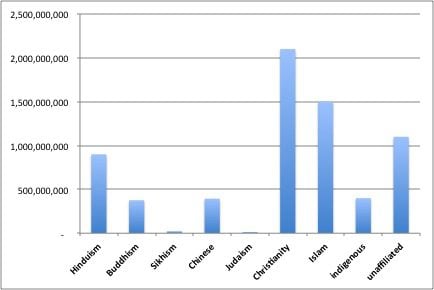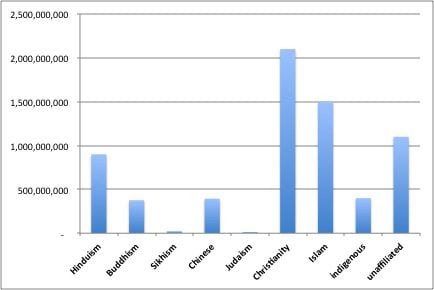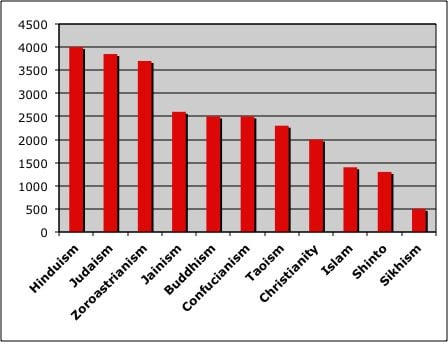In my previous blog entry (Part One of this series), I remarked that if I were from Mars, and knew absolutely nothing about Earth’s religions, then in order to begin to familiarize myself with the spiritual “lay of the land,” I’d probably start out by asking about the broad outlines of human religiosity:
How MANY religions are there?
How BIG are these religions?
How OLD are these religions?
I’ve previously addressed the question, How many religions are there? elsewhere.
And in my last blog, I addressed the question, How big are these religions? by providing a bar graph displaying actual specific total populations or number of adherents within each of the major world religions.
Note that with the exception of Sikhism and Judaism, the scale here is one of billions, rather than of mere millions:
However, the above graph just shows how the major religions rank, in terms of their own population sizes (their individual total numbers of adherents, worldwide). What about some of the other religions out there — the smaller but nevertheless fairly well-known religions that also make up a part of the world’s religious landscape?
How do some of these widely-known religious alternatives to the mainstream, established religions rank in size? How do their own populations compare in size to those of the major global faiths?
Well, here’s a representative sampling of some of the best-known among them, similarly bar-graphed:
In the above chart, I’ve included both Sikhism (23 million Sikhs worldwide) and Judaism (14 million Jews worldwide) purely for purposes of comparison. You can clearly see that both of them — the two smallest among the long-established major world religions, both in fact so numerically small that they barely even registered on the previous chart — nevertheless tower conspicuously above such relatively well-known but nevertheless miniscule religions as Baha’i, Rastafarianism, Scientology, the Unification Church, and Wicca.
In this chart, we’re now talking just millions, not billions.
Jainism, like Sikhism, is a religion native to India which is not particularly familiar to most Westerners. It’s a non-theistic faith which affirms severe asceticism and strict ahimsa (“harmlessness,” nonviolence to all living beings) as the path to liberation from the cycle of rebirth or reincarnation. Perhaps in part because of its uncompromising commitment to such rigorous demands (its nonviolent ideals inspired both Gandhi and Martin Luther King), Jainism’s population is tiny when compared to the major global faiths. There are perhaps only 6 million Jains in the world today.
Shinto is the life-affirming and at times rather “nationalistic” indigenous religion of Japan, revering nature and seeking blessings from the many kami (gods and spirits) of the Japanese islands. Most Japanese observe both Buddhist as well as Shinto practices and traditions with no sense of discontinuity or self-contraction, making it tricky for pollsters to try and figure out how many Buddhists vs. how many Shintoists there actually are in Japan.
In one sense, most Japanese are both Shinto and Buddhist, at the same time, and this could inflate the total Shintoist numbers immensely (some sources claim 80% to 90% of Japan’s total population of 128 million are Shinto); however, many if not most Japanese today actually self-identify as nonreligious, and observe Shinto practices more as a matter of cultural tradition than of genuine religious commitment. The actual number of practicing and “believing” Shinto adherents is currently estimated to be only somewhere around 4 million Japanese.
Zoroastrianism, the religion of ancient Persia, hangs by a thread today; only about 150,000 Zoroastrians remain in the world today, many of them in India (where they are known as Parsis or Parsees, “Persians”).
Wicca, the best-known of the various so-called “neo-Pagan” faiths, counts a total of perhaps 800,000 to 1 million Wiccan adherents (estimates vary, but this is probably a pretty close ballpark range, give or take).
Rastafarianism, popularly associated with reggae music, dreadlocks, and sacramental use of ganja (the holy herb marijuana), is estimated to have numbers roughly on par with that of Wicca — perhaps a million or so genuine adherents.
Scientology, despite its prominence in the media due to such high-profile celebrity adherents as Tom Cruise, Kirstie Alley, and John Travolta among others, is far smaller than one might expect. And while the Church of Scientology officially claims numbers in the region of 3.5 million, independent surveys tend not to support even such modestly high numbers; other sources suggest that the real number of actual Scientologists may be closer to the vicinity of only around 150,000 active adherents.
The Unification Church (whose members are sometimes unflatteringly referred to as “Moonies,” a term referencing the church’s Korean founder, the recently deceased Sun Myung Moon) also claims upwards of 3 million members, but outside observers again estimate a far lower total — perhaps only on the order of 500,000 actual adherents.
A relative giant among most of these smaller religions, the young Persian faith known as Baha’i (or more formally as the Baha’i Faith) is currently estimated to have somewhere in the neighborhood of perhaps up to 7 million followers worldwide.
Even bigger than the Baha’is are the Mormons, regarded by many pollsters, statisticians, and scholars of religion (not to mention, of course, by Mormons themselves) as a branch or form of Christianity, per se — at least in part because Mormons do self-identify as Christians, and despite the fact that many other Christians question or dispute the legitimacy of Mormon claims to be genuinely “Christian” in nature.
By far the largest Mormon sect is the Church of Jesus Christ of Latter-day Saints (or just LDS Church for short). With a current church membership of about 14 million, this main Mormon church has a total global population roughly equal to the total number of Jews in the world. (Within the U.S. alone, there are also about the same numbers of Jews as Mormons; each religion accounts for about 1.7% of American adults.)
So, there you have it: a look at how BIG many of the best-known religions — major and minor — actually are.
Next time: how OLD are all these religions? (Which of them are the oldest? Which are the youngest? How long ago were they each actually founded?)



